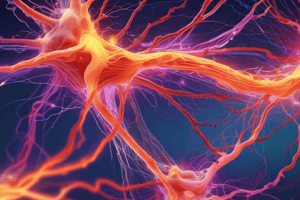Podcast
Questions and Answers
High extracellular concentration opens the voltage-gated sodium channels
High extracellular concentration opens the voltage-gated sodium channels
False (B)
Low extracellular concentration closes voltage-gated sodium channels
Low extracellular concentration closes voltage-gated sodium channels
False (B)
Entering cells through gated calcium channels causes depolarization
Entering cells through gated calcium channels causes depolarization
True (A)
Depolarization membrane has smaller charge difference
while
Hyperpolarization has a larger charge difference
Depolarization membrane has smaller charge difference while Hyperpolarization has a larger charge difference
Three major categories of axons:
Type A – myelinated (sensory and skeletal motor neurons)
Type B – lightly myelinated (ANS)
Type C – unmyelinated (ANS)
Three major categories of axons: Type A – myelinated (sensory and skeletal motor neurons) Type B – lightly myelinated (ANS) Type C – unmyelinated (ANS)
Membrane potential and flow of current occurs only at the bare areas called nodes of Han river.
Membrane potential and flow of current occurs only at the bare areas called nodes of Han river.
is a junction where the axon of one neuron interacts with another neuron or with cells of an effector organ?
is a junction where the axon of one neuron interacts with another neuron or with cells of an effector organ?
Neuronal Pathways and Summation
Neuronal Pathways and Summation
Refractory Period.
- the area becomes less sensitive to further stimulation.
Refractory Period.
- the area becomes less sensitive to further stimulation.
Flashcards are hidden until you start studying
Study Notes
Ion Channels and Membrane Potential
- High extracellular concentration of ions opens voltage-gated sodium channels
- Low extracellular concentration of ions closes voltage-gated sodium channels
- Influx of calcium ions through gated calcium channels causes depolarization
- Depolarization results in a smaller charge difference across the membrane
- Hyperpolarization results in a larger charge difference across the membrane
Axon Categories
- Type A axons: myelinated, found in sensory and skeletal motor neurons
- Type B axons: lightly myelinated, found in the Autonomic Nervous System (ANS)
- Type C axons: unmyelinated, found in the Autonomic Nervous System (ANS)
Action Potential Propagation
- Membrane potential and flow of current occur only at the bare areas called nodes of Ranvier
- Nodes of Ranvier are the uninsulated regions of the axon where the action potential is generated and propagated
Synaptic Transmission
- A synapse is a junction where the axon of one neuron interacts with another neuron or with cells of an effector organ
Refractory Period
- The refractory period is the period during which the axon becomes less sensitive to further stimulation
Studying That Suits You
Use AI to generate personalized quizzes and flashcards to suit your learning preferences.



